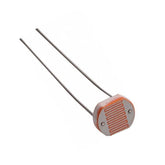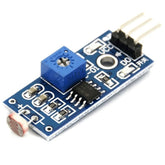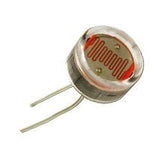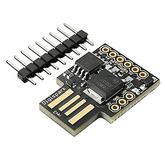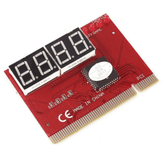What is the LDR Sensor?
Summary
Do you want to lighten up your knowledge of LDR sensors? Get an in-depth understanding of what LDRs are, how they work, the different types available, benefits, limitations, and various applications. Discover how these tiny light-sensitive sensors are revolutionizing industries and enhancing daily life. Stay ahead of the curve and find out how you can put LDRs to work for you!
Table of Contents:
- Introduction
- What is LDR
- Working Principle of LDR
- Variations in resistance to change in light intensity
- Light Dependent Resistor Circuit
- Types of LDR sensors
- How to Test LDR's Functionality
- LDR advantages and disadvantages
- Applications
- Conclusion
Introduction
A Light Dependent Resistor (LDR) is a type of passive electronic sensor used to detect light.
It’s made up of two conductors separated by an insulator which becomes more conducting when exposed to high levels of light intensity, forming a variable resistor in the circuit.
This allows it to measure the amount and brightness or darkness within its environment and provide information accordingly.

LDR light sensors are typically used as part of automated lighting control systems for energy conservation purposes such as dimming lights based on natural daylight that can be detected outside without human intervention.
Furthermore, they have found the application of LDR sensor in motion detectors like burglar alarm security systems because they can tell if something passes through their beamline quickly enough from dark-to-light conditions created with most forms of ambient lighting sources present today such as LED, etc., making them ideal sensing tools both commercially & domestic level settings alike.
Discover the magic of Light Dependent Resistors in electronics.
What is LDR?
An LDR, or Light Dependent Resistor is a type of optoelectronic sensor that's used for detecting light in the environment.
LDR works by sensing changes in illumination and converting them into electrical signals that can be read off from its two terminals.

This makes it an essential tool in many automation systems because it helps detect objects without any physical contact with them.
In addition to this, they have low power requirements making them ideal for energy-saving applications like solar cells and garden lighting systems where their high sensitivity allows precise illumination control even under tightly controlled conditions.
Their small size further increases flexibility as well giving these devices versatility across multiple different projects while still being able to fit inside tight spaces too!
Most home appliances, outdoor lighting, and streetlights are normally operated and maintained manually.
This is not only dangerous, but it also wastes energy due to staff negligence or unforeseeable events when turning this electrical equipment ON and OFF. Therefore, by using a light sensor, we can automatically shut off the loads based on the intensity of the daylight.
By sensing the radiant energy present in a relatively small range of frequencies often referred to as "light," which runs in frequency from the "Infra-red" to "Visible" up to "Ultraviolet" light spectrum, a light sensor produces an output signal that indicates the intensity of light.
The LDR light sensor is a passive component that produces an electrical signal from this "light energy," whether it is in the visible or infrared portions of the spectrum.
Because they transform light energy (photons) into electricity, light sensors are more generally referred to as "Photoelectric Devices" or "Photo Sensors" (electrons).

It can be divided into two primary categories: photovoltaics and photo-emissions and photo-resistors and photo-conductors, which modify their electrical properties.
LDR light sensor is also referred to as a photoresistor, photocell, or photoconductor. It is a specific kind of resistor, and the amount of light that strikes its surface affects how much resistance it exhibits.
A light-dependent resistor or LDR is an example of an electrical component that responds to light. When light beams strike it, the resistance changes right away. An LDR's resistance levels can vary by several orders of magnitude. As the light level rises, the resistance value will decrease.
LDR resistance values range from many megaohms in complete darkness to only a few hundred ohms in strong light.
As a result, these resistors are widely used in a variety of applications due to this variation in resistance. The wavelength of the incident light affects the LDR sensitivity as well.
Light Dependent Resistor (LDR) technology is widely used in many industrial, educational, and commercial applications. Its highly sensitive contactless operation allows it to replace mechanical switches for a wide range of needs.
The LDR sensor works as a light sensor or solar radiation detector, controlling street lights on highways, automatically changing the direction of traffic signals at intersections, and even photoelectric equipment such as smoke detector alarms all rely upon this small but efficient device which monitors changes from darkness into ambient light with impressive accuracy.
LDR works extensively to monitor temperatures inside refrigerators & freezers while keeping an eye out for heat/cool fluctuations that could cause food spoilage - ensuring optimal performance every single day!
In addition, inventor hobbyists are making great use of photoresistors by integrating them directly into their projects where they provide motion detection functionality and much more – giving everyone the ability to add innovation to already existing ideas!
Read our latest project Smart Street Lighting System using LDR Sensors and Arduino - Here.
Curious about Light Sensor? Learn more!
Working Principle of LDR:

The photoconductivity theory underlies the operation of this resistor. It is nothing more than the fact that when light strikes its surface, the material's conductivity decreases and the electrons in the device's valence band are stimulated to the conduction band.
These incident light photons must have energy larger than the semiconductor material's band gap. Consequently, the electrons quickly move from the valence band to the conduction band.
Also, read the different Types of Sensors in IoT
Variations in resistance to change in light intensity
The light-dependent resistor reacts to light very quickly. When the light is greater, which indicates that the resistance value for the LDR will be drastically reduced as the light intensity rises.

When an LDR light sensor is exposed to light, the resistance reduces; this is known as dark resistance. Conversely, when the resistor is exposed to darkness, the resistance decreases.
Any device that absorbs light will have significantly less resistance. The light intensity will increase, and the current flow will begin to increase if a stable voltage is applied. Therefore, the characteristics between resistance and illumination for a particular LDR are shown in the diagram below.
Since LDRs are not linear devices, the wavelength of the light that strikes them causes a change in their sensitivity. Because it depends on the material employed, some types of photocells are not at all sensitive to a particular range of wavelengths.
When light enters a photocell, the resistance changes within 8 milliseconds from 8 to 12 and takes a few extra seconds to return to its initial value after the light has been turned off. Therefore, this is referred to as a resistance recovery rate. This attribute applies to audio compressors.
Light Dependent Resistor Circuit:
The bridge rectifier circuit or a battery is used to provide the LDR circuit with the necessary DC voltage. This circuit converts the AC source to a DC source. To reduce the voltage from 230 volts to 12 volts, a step-down transformer is used in the bridge rectifier circuit.
DC voltage is converted by connecting diodes in a bridge-like manner. The voltage regulator is utilised to transform the 12v DC to 6v DC, and the circuit is subsequently powered by this DC voltage. The bridge rectifier and load must both have a constant 230v AC supply for the light sensor circuit to operate constantly.

When the resistance is low around 100 ohms. As can be seen in the light sensor circuit above, the power source passes through the LDR light sensor and ground through the variable resistor and resistor.
This is because the resistance provided by the light-dependent resistor is lower than the resistance of the remaining components of the sensor circuit during the day or when light is falling on the LDR circuit.
We are aware of the current principle, which states that current always flows in the direction of least resistance.
Types of LDR sensors:
There are two kinds of Light-dependent Resistor
1. Intrinsic Photo Resistors
2. Extrinsic Photo Resistors
1. Intrinsic Photo Resistors:
These resistors are pure semiconductors made of germanium or silicon. The number of charge carriers increases because of the electrons being stimulated from the valence band to the conduction band when light strikes the LDR.
2. Extrinsic Photo Resistors
The impurities that are added to these devices result in the creation of new energy bands above the valence band. There are electrons inside these bands. As a result, the band gap is reduced, and less energy is needed to move them. Long wavelengths are the principal application for these resistors.
Another kind of classification is done based on linearity,
- Because of their linear performance and method of operation, liner-type LDRs are sometimes referred to as photoresistors instead of photodiodes.
- The polarity via which they unite does not affect the behavior's of non-linear LDRs, even though they are frequently utilized.
How to Test LDR's Functionality:
Step 1: Set the multimeter to the Ohms mode. In this mode, resistance can be measured.
Step 2: Attach the two LDR portions to the multimeter's positive (usually red) and negative (usually black) terminal wires. Verify to ensure that the connections are secure.
Step 3: Use a torch or any other type of light source for lighting the LDR's surface. This will replicate the LDR's lighting condition.
Step 4: Verify the multimeter's reading. Note the value of resistance that the multimeter shows.
Step 5: Put the LDR circuit in a dark area or cover it with your hand at this point. This will simulate situations in which the LDR is not in contact with light.
Step 6: Once the LDR is covered or in darkness, recheck the multimeter reading again. When the multimeter displays the resistance value, note it down.
Step 7: Analyze and compare the readings for the two circumstances. In the first situation, where the object is exposed to light, you will typically find that the resistance value is lower. In the second situation when it is covered in the dark, the resistance value is greater.
Step 8: When an LDR circuit is covered or dark, its resistance is usually high, in the megaohm range. When exposed to light, its resistance decreases, sometimes reaching as low as 100Ω, depending on the strength of the light.
LDR advantages and disadvantages
Advantages
- Sensitivity is High
- Simple & Small devices
- Easily used
- Uses of LDR sensors in a variety of projects.
- Inexpensive
- There is no union potential.
- The light-dark resistance ratio is high.
- Its connection is simple
Disadvantages:
- The spectral response is limited.
- The best materials have limited temperature stability due to the hysteresis effect.
- Its chemical reaction in stable materials.
- LDR Sensor is only used in situations when the light signal fluctuates dramatically.
- It is not a particularly responsive tool.
- As soon as the operating temperature changes, it gives the wrong results.
Applications:
LDR sensors find diverse applications in daily life, serving as key components in various systems.
The uses of LDR sensors can be from controlling streetlights and enhancing security systems to optimizing solar panel efficiency and aiding photographers in capturing the perfect shot. LDR sensors in daily life include.
- The photoresistor is typically used to measure light intensity and presence.
- These sensors are used in lights that turn on and off automatically based on light
- Smoke Detector Alarm, Automatic Lighting Clock
- These sensors are used in the design of optical circuits
- Proximity switch for photos
- Security measures utilizing lasers
- In Solar street lighting it can be used
- Light meters for cameras
- It can be used in Radio clocks
- Can be used in dynamic compressors; some compressors adjust the signal gain by connecting LDR circuit and LED to the signal source.
Conclusion
In this blog post, we have learned that Light Dependent Resistors (LDRs) play a vital role in modern technology, providing an effective way to detect light levels, control various electrical systems, and various uses.
With a deep understanding of their LDR sensor working principle, types, advantages, disadvantages, applications, and dynamic range, one can take full advantage of this amazing technology and optimize the LDR circuit light sensor range for specific needs.
Whether you're an engineer looking to improve your designs or an enthusiast seeking to learn more about LDRs, this blog has got you covered. Don't miss out on the opportunity to experience the power of LDR technology.
If you appreciate our work don't forget to share this post and leave your opinion in the comment box.
Please do check out other blog posts about Popular electronics
Make sure you check out our wide range of products and collections (we offer some exciting deals!)



